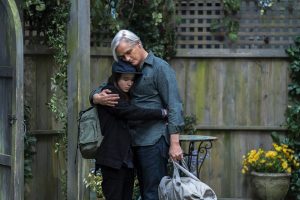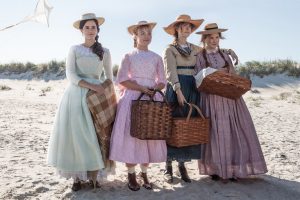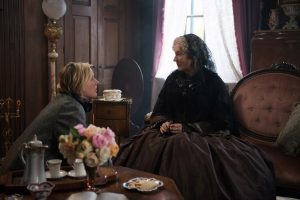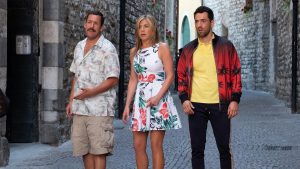As Pride Month draws to a close, you have just enough time still to binge-watch Netflix’s modernized reboot of the 1993 soap opera Tales of the City, which is in turn based off the 1978 novel by Armistead Maupin. But even if you don’t know the original series (I didn’t), this show somehow manages to perfectly convey the feeling of coming home – to the house on the hill at 28 Barbary Lane in San Francisco. That’s especially due to cast, social commentary and atmosphere, all of which intertwine in an almost intoxicating blend of nostalgia.

The cast includes series regulars Laura Linney and Paul Gross, along with the show’s main attraction, Olympia Dukakis, reprising her groundbreaking role as Anna Madrigal, the beloved elderly transgender landlady of Barbary Lane – this time around, she comes loaded with a dark backstory and a few scandalous secrets, not unlike the diverse group of characters, young and old, who live in her apartment complex. There’s Shawna (Elliot Page), supposedly the show’s protagonist, but whose story tends to get lost among all the intersecting threads and character arcs – or maybe it’s just because every time Shawna shares the screen with her girlfriend Claire Duncan (Zosia Mamet), the energy and vitality of the show grinds to a halt, while the two stare blankly at each other and mumble. Paul Gross returns as Shawna’s adoptive father, Brian Hawkins, while Linney is once again the naive, wide-eyed Mary Ann Singleton – but unlike in other iterations of the show, Barbary Lane is only temporarily seen from Mary Ann’s POV. Instead, the focus has wisely been shifted on the real, down-to-earth residents of San Francisco: interracial gay couple Michael Tolliver (Murray Bartlett) and Ben Marshall (Charlie Barnett); Asian-American twins and Instagram influencers Ani and Jonathan Winter (Ashley Park and Christopher Larkin); Hispanic transgender/genderqueer nurse Jake Rodriguez (Garcia) and his lesbian girlfriend Margot Park (May Hong); and especially Black cross-dressing nightclub owner Ida Best (Caldwell Tidicue), who has one absolutely awesome scene in Episode 9, donning a silver wig and high heels while leading a troop of Rainbow Warriors into battle against injustice. It’s really not that surprising that Elliot Page gets swallowed up by this rich, diverse cast – his performance is good, but far too low-energy to make him stand out in the crowds of witty drag queens, nursing home troublemakers, and nasty dinner guests.
These people are the products of a brilliant, flamboyant, free-spirited society in the streets of San Francisco: not only its beautiful vistas, sunsets, parks, high-rises or even its oases like Barbary Lane, but also its darker, grittier side. This is made especially clear in Episode 8, an extended flashback to Anna Madrigal’s early life in the city soon after her transition: here, Madrigal attempts to navigate her dangerous new existence as a transgender woman in 1966, and finds herself having to do anything possible to survive. Her “house on the hill” wasn’t built by goodwill and fortune-cookie wisdom alone, as it turns out. The show has an interesting, thoughtful commentary on the history and progression of the LGBTQ+ Rights Movement, from Anna’s flashback to one intensely awkward conversation about the privileges of gay men who survived the AIDS crisis. Characters like Ysela (Daniela Vega) and the everyday struggles we see briefly through her eyes as she protects the city’s homeless, show us that no matter how far we’ve come, we have to keep going. And Anna, when she is interviewed, sums it up best when she explains that the city hasn’t changed very much at all since the 1960s – people still make mistakes, and they still have to deal with the consequences and try to make things better.
This commentary would make for one pretty grim show if it weren’t for the fact that Tales of the City actually has a really hard time balancing its two main narratives – the show tries as best as it can to give equal screentime to the family-drama and the LGBT crime thriller that make up its plot: considering that both of these stories literally operate out of the same house, this should have been much more seamless than it ended up being. But if I have one complaint about the show, it would be that – not only is the story lopsided, it can’t even figure out which way it wants to…lop (is lop a word? What is a lopside?) at any given time: one of the most bizarre examples is when a humorous but suspenseful car-chase abruptly turns into a mother/daughter quarrel. Throughout the middle of the show, there are interminable arguments about relationships, parenting, interactive art, etc, etc, and the show begins to get lost – along with many of its characters, who either randomly disappear around the midpoint, or just wander around in the background to give the illusion that they’re doing something relevant as the family-drama plot increasingly narrows in on Mary Ann, Brian and Shawna, while also trying to spare just enough time on Michael and Ben to still give a gay viewpoint on the story.
And then, in the last three episodes of the show, the family-drama stuff basically gets thrown out the window, in place of the crime story – which, honestly, is much more interesting. The finale neatly wraps up that storyline, in a weirdly cartoonish but still entertaining fashion – literally, in fact. Many of the storylines explored in the family-drama plot, however, are left open to interpretation.
Which brings me to a sentiment I expressed early today in an Instagram post, where I said that I need more Tales of the City content. There is ample opportunity for spinoffs and sequels about these characters: I think this show maybe bit off more than it could chew, but a smaller-scale, more intimate series about one of the show’s supporting cast could be very satisfying – for goodness sake, I’d be willing to watch an entire show about DeDe Day’s butler!
I don’t know if I’ll write a Spoiler Review for this show, but there is definitely a lot to talk about regarding the series – so leave your thoughts in the comments below!
Season Rating: 7.9/10


